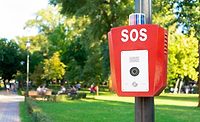As students return to school, it’s important that administrators are prepared to address the safety, behavioral, and mental health challenges that lay ahead. Some students were already struggling with their mental health prior to the pandemic and it has only become a bigger challenge. When asked in a survey, “How has COVID-19 impacted your mental health,” 60% of high school students answered that their mental health had worsened or worsened significantly. This is concerning because young people’s mental health needs were already not being met before the pandemic. In a study from 2017-2018, it was found that “60% of youth with major depression did not receive any mental health treatment.” and “Even in states with the greatest access, over 38% are not receiving the mental health services they need.” Now, it’s more important than ever that schools are equipped with the tools they need to properly address students’ mental health.
Many schools are adopting technology solutions, specifically around student engagement, behavioral health, and safety mood monitoring technology to address students’ needs. These tools can help schools improve their ability to properly identify any students that may be struggling, as well as support all students through the process of acclimating to a new routine. These tools leverage numerous ways to identify students that need help, such as surveys, routine mood reporting/monitoring, and data analytics.
A data analytics platform is great for making use of the data a school already collects, such as students’ attendance, tardiness, and grades. Rather than having all of this data separate, an analytics platform is able to aggregate all of it, organize it, and display it in one place. When this information is automatically organized and displayed through graphs and charts, it’s much easier to digest and can reveal important insights into a student’s mental or behavioral health that could have otherwise gone unnoticed. For instance, when a student’s grades suddenly or dramatically drop it’s an obvious red-flag and school faculty often step in, however, less dramatic changes don’t grab as much attention. With an analytics dashboard, even small changes are easy to track, especially because multiple data sets are displayed together. For instance, school staff can access a student’s snapshot that reveals they’ve had a slight decrease in their grades as well as an unusual increase in absences. When revealed together, this can indicate to school faculty that something may be going on with the student and that someone should talk to them.
Schools can also record additional data that can help reveal mental health concerns in their students. For instance, recording a student’s moods can be a great way to flag students who may need additional support that would otherwise go unrecognized. This information can be recorded by teachers based on their observations in the classroom or it could be self-reported by students via digital surveys. Teachers observe a lot in the classroom, but it can be difficult to keep track of every individual and their behavior modifications all on their own, especially in times of digital learning. With an in-room portal, teachers can log their students’ daily moods or even a weekly overview on a scale from 1-10, even when they aren’t physically in the classroom. The analytics platform will then also aggregate this data and display it in the dashboard which can help reveal important patterns or trends in students’ mood. For example, a student might continually show up to class upset on Fridays. This pattern would be hard for a teacher to recognize on their own, but when the data is recorded and displayed it can’t be missed. With this information, a faculty member can speak with the student to see if there’s a problem and why it may be recurring on each Friday.
This proactive approach can help students get the support or help they need before there is a major issue or incident. Often people only receive mental health or other support after something detrimental has occurred, but this doesn’t need to be the case. In school, students can’t afford to fail their classes or experience repeated bullying before they receive help. Schools should instead focus on being proactive and reaching out to students so these situations can be deterred, however, achieving this can be difficult as schools are underfunded and don’t often have the technology in place to help. Fortunately, with the recent passing of the American Rescue Plan Act of 2021, schools are now receiving additional funding to address learning loss and behavioral health challenges students face as they return to in-person learning. The $170.3 billion investment in education (from kindergarten to higher ed) is the largest single federal government investment in schools to meet what educators are saying is the largest needs gap in students’ lifetimes. With this funding, schools can invest in proactive technology.
Even with a proactive approach, there are certain situations that schools can’t always get ahead of. This is why legislation to enhance school safety, such as Alyssa’s Law, is becoming more and more common in a number of states. Alyssa’s Law, which has already passed in Florida and New Jersey, requires that a state’s public schools install technology that can silently alert law enforcement in the case of a school emergency. These measures can minimize response times and potentially save lives in a crisis. When implementing rapid response technology to meet these requirements, it’s important that schools ensure their chosen technology ties into their larger school safety technology suite as well.
One way to meet the requirements of Alyssa’s Law while creating a holistic safety solution for schools is to leverage an automated alerting platform that can integrate numerous systems into one platform. Not only is this platform capable of mobile duress, fixed duress, and other panic button/rapid response triggers, but it can also tie into a school’s door access control system, fire and smoke detection, environmental monitoring technology, and so much more. When equipped with an automated alerting platform, school staff can trigger an emergency response with the press of a button. For instance, if a teacher noticed a suspicious person in the building they could press a wearable button that would contact the police and even provide them with specific information such as which teacher pressed the button and their whereabouts in the building. This technology could also be leveraged in other scenarios ranging from benign to a crisis, whether it’s a fire or a leak in the bathroom.
Whether a school is looking for technology to help address students’ mental and behavioral health or technology to improve school safety measures, the most important thing is to focus on creating a holistic safety solution. This means that every system should be contributing to the bigger picture, and not be siloed. By equipping schools with both reactive and proactive technology, administrators can ensure they’ve covered all of their bases to ensure as safe an environment as possible for their students and staff.



